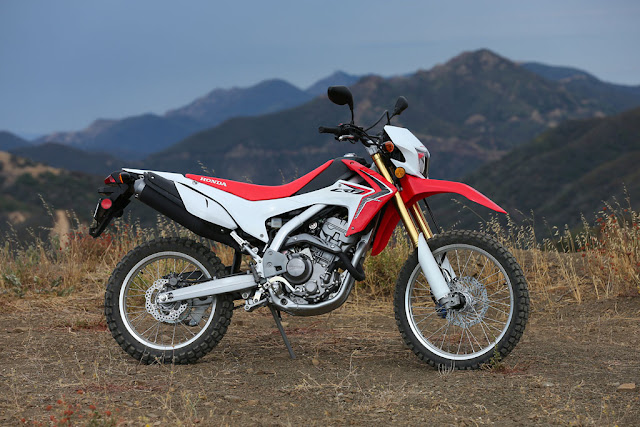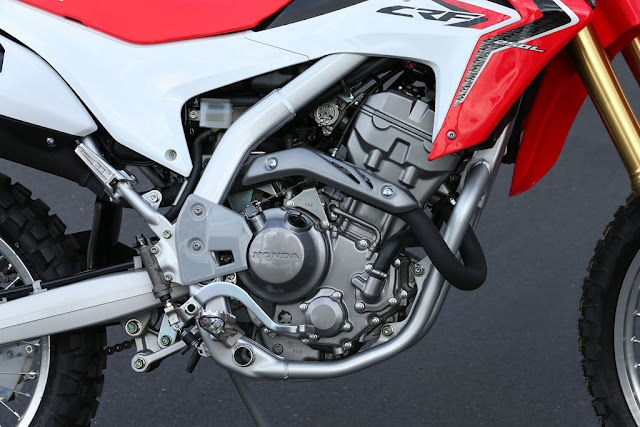RED-2013 HONDA CRF250L
That Honda has taken a staid approach to the two-wheeled world these past few years isn’t news. However, when Big Red does get around to fabbing up a new model, the company does it right. The all-new CRF250L dual-sport is a beaming example of what Honda can do when it wants to make its mark and let people know that this motorcycle company is still a force in the market.The 250 not only serves as a replacement for the outgoing CRF230L, the 250 will make you forget the 230 ever existed.
Where the 230, with its air-cooled, carbureted engine, and square-headlight-havin’ style, made it difficult to decipher just how many decades this bike was in Honda’s lineup, the 250 brings Honda into the present day; and in some ways lets the competition know they’re getting left behind.
The well-received CBR250R streetbike lends its liquid-cooled, fuel-injected 249cc single cylinder engine to the CRF250L. But in dual-sport service the Single was tweaked and tuned to provide improved low and mid-range performance, making it more suitable to the lower rpm demands of off-road riding.
Unique to the 250L is its own ECU, new intake manifold with a straighter path from the (new) airbox to the cylinder head, and a head pipe that’s smaller in diameter (down from 31.8mm in the CBR250R to 28.6mm) but about 200mm longer. A new muffler and a smaller throttle body (36mm vs. 38mm on the CBR) also target low- and mid-range performance. Other changes made for the CRF250L’s off-road applications include a new clutch with a judder spring to absorb shock loads through the driveline, as well as a dirt-tough gearbox with wider gears and strengthened dogs. The internal gear ratios remain unchanged from those in the CBR250R, but lower final gearing is achieved via a 40-tooth rear-wheel sprocket in lieu of a 38-tooth sprocket.
The CRF gets an all-new semi-double-cradle-type steel frame with a tapered aluminum swingarm, and is suspended in front by a 43mm Showa inverted fork, while a Honda Pro-Link shock handles rear suspension. The fork provides 9.8 inches of travel, and the shock 9.4 inches; however, neither offers any means of adjustment. A seat height of 34.7 inches should welcome most riders.
Honda says ready to ride, with its 2.0-gallon tank full, the new CRF250L weighs 320 pounds. Honda also claims the 250 will get 73 miles to the gallon.
Styling is modern, taking cues from the larger displacement off-road and motocross models in Honda’s dirtbike lineup. Gone are the 230L’s dated-looking square headlight and turn signals; the 250L wears a sharp new headlamp, and the turn signals’s sleek tapered shape tie in perfectly to the overall styling theme.
Switchgear is also fresh, looking similar to switch housings on a number of Honda’s streetbikes. The new all-LCD instrument panel is easy to read at a glance, and two large buttons make toggling through the display with gloved hands a cinch. A few welcome but unexpected extras include four bungee hook points at the rear of the seat and believe it or not, the CRF has an easily accessed helmet lock. The only thing we’re puzzled by is the chromed gas cap on a dirt-oriented motorcycle, but we’re at least glad the cap is lockable.
The 250L is a competent package, and a well-rounded motorcycle, but perhaps most impressive is the engine. Manufacturers will often claim qualities or performance that aren’t necessarily tangible, but promises are delivered on when it comes to the strong low-end and mid-range power Honda boasts for this dual-purpose 250.
Fueling is flawless at any speed/rpm and throttle response is seamless, allowing the engine to pull cleanly at low revs, even as high as third gear. The engine’s wiliness to grunt it out from down low is noticeable in the street as well as off-road; it has a considerable amount of pep for a mild-mannered 250, easily climbing steep sections of trail. Furthermore, this is one of the smoothest-running small-displacement Singles on the market, thanks in part to the counterbalancer Honda employed when drafting the engine. It spins so smoothly that Honda saw no need to use vibration-quelling rubber inserts in the large, dirtbike style footpegs.
Shifting action from the six-speed trans is transparent and precise.
The CRF-L’s street manners are commendable, providing light, accurate steering response without feeling twitchy. The chassis is stable at any point in a turn, with equally composed straight-line handling.
The fork would occasionally hit the bottom of its stroke when encountering larger rocks and deep ruts at speeds high enough to fully compress the fork’s springs, otherwise, off- and on-road ride quality from the suspension is comfortable, yet you rarely feel like the springs are overwhelmed. Suspension performance strikes a perfect balance between eating up rugged single-track with little complaint while offering stability and comfort on the pavement.
Yamaha’s entry in the 250 d-s class, the WR250R, sets the bar high by providing a fuel-injected, liquid-cooled engine, aluminum frame, and fully adjustable suspension with one additional inch of travel than the new CRF250L. But, you’ll pay a pretty penny for the WR at just less than $6700. The KLX250S from Kawi also bests the CRF with adjustable suspension, but is still carbureted, and rings in with a $5100 tag.
With so many improvements found in the CRF250L as compared to the 230L, logic says the Honda, like many Hondas these days, will make for a pricey machine. However, Big Red has made the CRF as a “world model,” with the engine produced in the company’s Thailand facility, and therefore can better meet the pricing challenge of other markets that demand cheap products.
North American consumers benefit from Honda’s increased production volume for this model that drives down pricing, and will now pay a mere $4499 for the 2013 CRF250L. Yep, you read correctly. That MSRP is $500 less than the last new model year (2009) of the dated, softly sprung, and anemic CRF230L.


